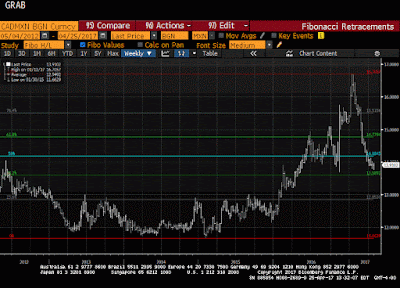The Trump Administration has switched gears.
During the campaign through the inauguration, Trump picked on
Mexico. The rhetoric and threats drove the peso to record lows. By
the OECD's calculation the peso more than 150% undervalued.
The re-opening of NAFTA negotiations was
supposed to be aimed more at Mexico than
Canada. Sentiment turned about the peso, The central bank hiked
rates and changed their intervention tactics so it would not drain
reserves. Since January 11, the peso has appreciated by more than 15.5%
after pulling back nearly one percent this week.
It turns out despite insisting
that Mexico will pay for the border wall, Trump's demand that Congress
authorize the funding while cutting other
programs is one of the issues that is
pushing the US government again to the brink of its spending authorization.
Some reports suggest that President Trump is prepared to seek to fund for it in the FY18 budget that will be negotiated later this year. Also, the
controversial border adjustment tax does not look like it will be incorporated into the tax reform that the
White House proposes.
The US wrath has turned to
Canada. Commerce Secretary Ross took on the lumber dispute which
arose in the Obama Administration. The issue is subsidized logging. The US will impose countervailing
duties (ranging from 3% to 24%) on five Canadian companies that export lumber
to the US. Moreover, the duties are retroactive, because, as Ross
explained, Canada knew that it was being investigated and continued with its
practice.
The US National Association of
Home Builders estimates that the duty
will increase the price of building a home by $1000, which would be enough
apparently to make another 150k American
families unable to afford home ownership. Canada argues that the US
has challenged Canada's practice since 1983 (before NAFTA) and various
international tribunals have found against the US claims. Ross dismisses
the findings under NAFTA's conflict resolution mechanism because Canada names
three of the five members. This would
likely be one of the things the US seeks to change when NAFTA negotiations
begin.
President Trump tweeted about
Canada's unfair dairy practices. It is true that Canada protects its
dairy farmers with tariffs and domestic output controls. Canada exported
about $112.5 mln of dairy products to the US last year, while the US exported
$631.5 mln of dairy products to Canada. In fairness, US complaints about
Canada's dairy practices are not new. They go back several years.
However, in 2016, Canada implemented new policies to facilitate a new class of milk prices, for a liquid
concentrate that could be used to make cheese and yogurt. It lowered the
price for this milk product to encourage domestic production and compete with
the US-sourced product.
With today's losses, the
Canadian dollar is the only G10 currency to fall against the US dollar this
year. It is off about 1.1.% at the lows for the year. The Great Graphic
(created on Bloomberg) shows the Canadian
dollar against the Mexican peso on a weekly basis over the past five
years. The recovery of the Mexican peso has driven the cross
lower. It has approached the 61.8% retracement objective of the big rally
since the start of 2015.
Looking more closely at the recent price action, today's low did
not take out yesterday's low as the peso is even weaker than the Canadian
dollar. Moreover, the technical indicators we use (RSI, MACDs and
Slow Stochastics) all show a bullish divergence. That is to say that
although the cross made a new low for the year yesterday, the technical
indicators did not confirm it, and instead are trending
higher.
The Canadian dollar is near
MXN13.91. A move above last week's high near MXN14.025 would provide
further evidence that a low may be in place. The Canadian dollar has not
closed above its 20-day moving average against the peso since late
January. It is found near MXN13.97.
While we are not keen on
picking a top to the US dollar against the Canadian dollar, the Loonie looks better against the Mexican peso.
The dollar's downside momentum against the Canadian dollar has faded over the
past couple of weeks near MXN18.50, after peaking near MXN22.00.
The US dollar is holding above its 20-day moving average against the peso for
the first time since January. A move
above MXN19.00 could spur a move toward MXN19.50-MXN20.00.
NAFTA Trade Update
 Reviewed by Marc Chandler
on
April 25, 2017
Rating:
Reviewed by Marc Chandler
on
April 25, 2017
Rating:
 Reviewed by Marc Chandler
on
April 25, 2017
Rating:
Reviewed by Marc Chandler
on
April 25, 2017
Rating:






